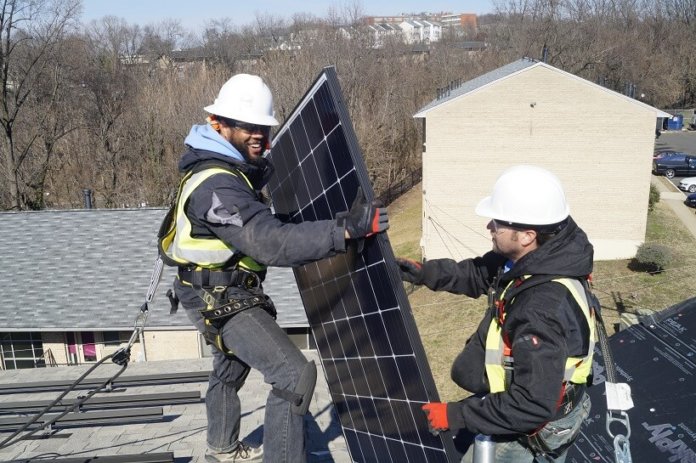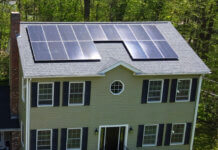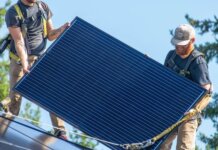Since 2001, nonprofit solar installer GRID Alternatives has been on a mission to bring more solar energy to underserved communities. In addition to installing solar for low-income families in California, Colorado, the Mid-Atlantic and tribal nations, GRID also focuses on providing solar job training. Solar Industry caught up with two recent graduates of GRID’s training program in Washington, D.C., where new renewable energy mandates could portend a major jobs market for solar in the future.
Steven Donerson and Vernon Davis, who completed GRID Mid-Atlantic’s Solar Works DC training program, both began working as multifamily solar installers with the nonprofit on Jan. 14.
Launched in 2017 in partnership with the city’s existing Solar for All program, Solar Works DC – open to District residents 18 or older – provides a 12-week training program that includes not just in-classroom education but also real-world experience up on the roof.
“It seemed like a match made in heaven,” says Donerson, referring to his coming across the Solar Works DC program after having searched for opportunities in solar for 15-20 years.
For Donerson, whose diverse job background spans the military, the music industry and other nonprofits, the best part of his new career is knowing that he is making a difference in his community by helping to lower electricity costs for clients; and the everyday hands-on work – the “thrill of being up on the roof,” he says – isn’t too shabby, either.
What first piqued his interest in solar was learning about Nikola Tesla in college, where Donerson studied electrical theory and repair.
“I wanted to use my skills to better my community and my country as a whole,” he explains regarding his decision to enter the solar industry. By learning a new skill through GRID, Donerson was able to launch what he calls his “second career.”
For Davis, who works alongside Donerson, entering the renewable energy industry was also a way to put his skills to use in an entirely new career.
Already certified in building and apartment maintenance, Davis’ job background also includes environmental management and elderly caretaking, but when he sought a change of pace, he found that solar was “right up [his] alley.”
With solar PV Occupational Safety and Health Administration (OSHA) certification under his belt, Davis also finds a major perk of the job to simply be the labor itself: “I like working with my hands,” he explains, adding that he has now “developed a passion” for building solar.
For Davis, he cites the camaraderie as another perk of his new job, calling the “working relationship” among his co-workers and his management “priceless.”
Moreover, Donerson notes, “[GRID’s training] made all the difference in my life personally.” He calls it a “fantastic program” geared toward those who may not know “what direction they want to go in” career-wise.

It’s no secret that solar jobs fells overall last year, with The Solar Foundation (TSF) recently reporting a 3.2% drop in the U.S. in 2018 over 2017. In D.C. in particular, solar jobs went down nearly 16%, from 1,294 to 1,092 last year, according to the foundation’s 2018 jobs report.
However, the report expects the country’s numbers to pick up this year and rise 7%. In Washington, D.C., in particular, there are undoubtedly big things to come, with the nation’s capital having enacted a bold new renewable energy goal: In January, Mayor Muriel Bowser signed the Clean Energy D.C. Omnibus Act of 2018, which officially committed the city to transition to 100% renewable electricity by 2032.
“It’s a great opportunity for residents of D.C. to make the transition from traditional electrical to solar,” remarks Donerson.
Davis notes that although the law still remains in its “early stages,” he encourages those looking to enter the solar jobs industry to “get actively involved now.”
Laura Vendetta, director of programs for GRID Mid-Atlantic, emphasizes the need to grow the District’s solar workforce in light of its new clean energy law.
“In order to achieve the District’s 100 percent renewable energy goal, a skilled workforce is essential in supporting the rapid growth and development of clean energy projects in the District, including the innovative programming and projects that serve D.C.’s most underserved communities,” says Vendetta, referencing the city’s Solar for All program, which “opens doors of opportunity through Solar Works DC.”
TSF’s newly released fact sheet for D.C. solar jobs adds that although the city did see losses last year, its “strong renewable energy policies will lead to increased solar capacity and support thousands more jobs.”
Of course, this means more opportunities for those looking to make a start in solar – and GRID, through its various training programs across the country, aims to be there during every step of the process. With offices in California, Colorado and Washington, D.C., the nonprofit has trained nearly 41,000 participants through its programs to date, as well as connected them to job opportunities after graduation.
“They have gone beyond the call of duty to put the word out about renewable energy and solar,” says Donerson.
He says GRID’s training also presents a “wide field” of options for him going forward. Right now, he is engaged in OSHA certification and is planning for a North American Board of Certified Energy Practitioners exam to further his career in solar.
For full-time solar installers, TSF’s jobs report said median entry-level wages were $24.32/hour for solar PV electricians and $18.92 for non-electricians in 2018, putting these numbers above the U.S.’ national median wage. Beyond entry-level, median wages for mid-level workers were $32.43 for electricians and $28.11 for non-electricians. Overall, the report concluded that the U.S. solar industry offers “competitive wages for both entry-level and mid-career employees.”
Of all U.S. solar jobs in 2018, those in installation and project development comprised 64%, representing a 138% increase from 2010 but a 6.1% drop from 2017, says TSF’s report. Nonetheless, they are expected to go up 9% this year.
Importantly, the jobs census noted that only 15.1% of new hires in installation and project development had a bachelor’s degree or higher in 2018, and 60.9% had prior experience – meaning that it’s never too late to join the industry, whether you want to hone a skill or bring a longtime passion to fruition, as demonstrated by GRID’s latest successful graduates.




